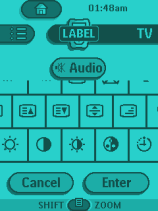|
...Continued from Page 6.
After entering "Learn" mode, teaching a command is accomplished by aligning the two remotes (source remote pointing at the bottom of the Pronto), selecting the button to learn to on the TSU2000, then pressing and holding the key to capture the signal from. If learning succeeds "OK" will flash, otherwise "FAIL". The Pronto's learning frequency range is one of the smallest around - only up to 56kHz. Many other remotes support up to 150kHz or even 455kHz. The Marantz RC2000 MkII, made by a sister company to Philips, can capture up to 1.15MHz. Although this could seem a strong limitation for the Pronto, most devices do fall under the 56kHz limit. Indeed, Philips has even managed to coax the software into recognizing certain high-frequency codes and, regardless that it can't capture them, figure out what they should have been. In addition, the IR transmitter on the Pronto is perfectly capable of transmitting at higher frequencies, so if someone can manually generate a configuration for a high-frequency device it will work. Learning is quick and reliable, only requiring you to select the button to teach - there are no additional compulsory confirmations.
It's interesting to note that if you change a preprogrammed device brand after learning infrared signals, any buttons since learned on will remain - even if they should have been overwritten with a new signal. In the device testing stage, any buttons that have a new function taught will simply not show. Otherwise, there is no way to differentiate between a button that contains a preprogrammed or learned signal - and if you overwrite a preprogrammed button, no way to restore it without reassigning the whole device.
The "hard" kind of functionality...
Although the Pronto employs no concept of "punch-throughs" for LCD buttons - you simply learn what you want where you want - its 7 user-configurable hard buttons are a different story. All of them can be configured on a system-wide or device-only basis. For instance, anything assigned to a hard button on one device panel will automatically continue through all other panels under the same device. If something is assigned to a button on the "Home Menu", that will be passed through each and every device and macro group, unless something else was specifically programmed. So, if you wanted to use your amplifier's volume controls for all devices, just learn them on the Home Page and ensure no device has a different hard button assignment. If you want to control the TV's audio under a few of those devices, just learn the TV's volume controls to them. It's a simple and efficient feature.

Labeling a button. |
Labeling for success.
Chances are, if you learned a few new commands the default button labels will clash like an orange suit with a purple tie. The Pronto's alphanumeric equivalent to the Armani suit is the "Label" function. Much like learning codes, the label function shows all possible buttons and panels, whether they're in use or not. You can change the label on existing buttons, or even on buttons that don't yet have a function - handy if you'd like to plan your layout before learning. When labeling, the Pronto provides a full QWERTY keyboard in miniature. Pressing a section of the keyboard zooms in for your final selection. A full complement of characters are provided - upper and lowercase letters, numbers, ASCII symbols, transport symbols, function icons and international accented letters. In all, a total of 191 characters are available, quite a bit more than any other remote.
Through the "Label" function you can also rename devices. Just open the device menu and hold down the bottom left or right hard button while tapping the name. All changes will be reflected on the "Home Menu".
| 
